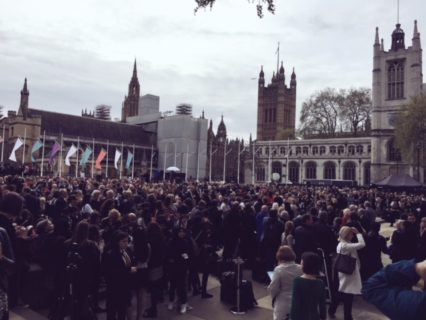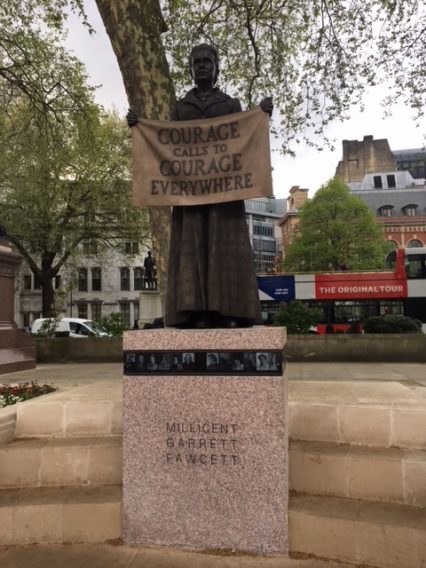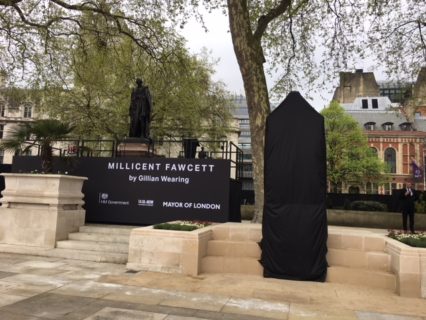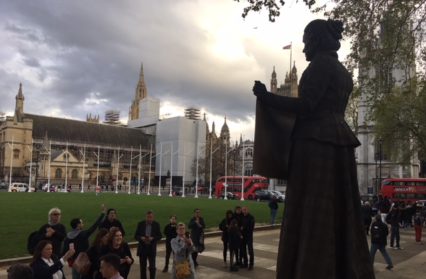A statue of suffragist leader Millicent Fawcett was unveiled in Parliament Square this week, the first ever statue of a woman to be placed there. Cerith Mathias was in London to watch the proceedings.
A small, but significant patch of grass in the heart of Westminster has been the focus of much attention this week. An island of green in a sea of imposingly important buildings – the Houses of Parliament in front, the Supreme Court behind, Westminster Abbey and Whitehall either side, Parliament Square is perhaps one of the most symbolic lawns in the land. For years it has housed statues of individuals celebrated not only for shaping British political history, but democracy throughout the world also. Historically, the group of eleven gathered there in their bronze and granite guises have shared a common feature. They are all men, celebrating the contributions of men.
 That is until this week when, with much celebration, a twelfth statue was added to their ranks – the first ever of a woman, and the first ever designed and made by a woman to stand in the square. The arrival of suffragist leader Millicent Fawcett forever altering both the tone and focus of the deeds and words celebrated in the shadow of Parliament, to include for the first time the achievements of women.
That is until this week when, with much celebration, a twelfth statue was added to their ranks – the first ever of a woman, and the first ever designed and made by a woman to stand in the square. The arrival of suffragist leader Millicent Fawcett forever altering both the tone and focus of the deeds and words celebrated in the shadow of Parliament, to include for the first time the achievements of women.
The statue of Millicent Fawcett forms part of this year’s celebrations of the centenary of the Representation of the People Act, which gave some women – those over 30 who owned property or whose husbands owned property, the right to vote. A right Fawcett dedicated her life’s work to winning. Ideologically radical, yet a believer of non-violent, legal means of effecting change, Fawcett established the National Union of Women’s Suffrage Societies in 1897. Opposing the militancy of Emmeline Pankhurst’s suffragettes, Fawcett said in a speech in 1911 that the NUWSS was ‘…like a glacier; slow moving but unstoppable.’ Twenty-one years after the society was formed, she was present in the House of Commons when the franchise was extended to all women. She died a year later in 1929.
On this grey Westminster morning the usual hustle and bustle of London traffic is paused, the roads around Parliament Square cordoned off, cars and buses replaced by a procession of people – dignitaries, women’s rights campaigners, and curious members of the public all making their way to witness a moment many claim is years overdue.
Brightly coloured flags flap in the April breeze; the red, white and green of Millicent Fawcett’s suffragists and the purple, white and green of Emmeline Pankhurst’s suffragettes line the square. At the far end, a stage has been erected, next to it a giant screen – an indication of the numbers expected here today. In the corner, just a little along from a statue of Mahatma Gandhi, and under the watchful gaze of Abraham Lincoln, a figure is cloaked in black. Here stands Millicent Fawcett, as imagined by Turner-Prize winning artist Gillian Wearing, waiting to be unveiled to the world.
‘There she is! Under the black sheet,’ I hear a teenage girl knowingly inform a group of her classmates as they pass by, her finger-waving met with a chorus of excited gasps. As they make their way to the rows of white seats set up in front of the stage, the Suffragist Singers, bedecked in red, white and green sashes burst into song, the marching anthems of the suffrage movement filling the air.
At just a little after half past eleven, as the clouds break momentarily allowing shards of sun to streak across the substantial crowd gathered, the cover is whisked from Fawcett’s frame. There she stands, bold in bronze, her steely stare fixed on the Houses of Parliament straight ahead. She holds aloft a banner that reads ‘Courage Calls to Courage Everywhere.’
The statue honouring Fawcett’s contribution to women’s history was commissioned following a campaign by writer and broadcaster Caroline Criado Perez, who also successfully lobbied for Jane Austen’s image to appear on the ten-pound note.
‘I’m so grateful to everyone who worked so hard on this’ she tells the crowd.
‘It’s been a brilliant team effort, and one I’m so proud to have played a part in.’
 Indeed, much like the battle for the vote, the statue is the result of a collaborative effort, of an outcry of voices calling for change. The idea first came to Perez on a run through Westminster. Crossing Parliament Square, she noticed the male-only monuments.
Indeed, much like the battle for the vote, the statue is the result of a collaborative effort, of an outcry of voices calling for change. The idea first came to Perez on a run through Westminster. Crossing Parliament Square, she noticed the male-only monuments.
‘As I carried on running through St James’ Park, I realised I couldn’t get it out of my head.’ Perez says.
‘As I rounded Green Park, I realised I was composing the campaign text in my head. When I came back around to Buckingham Palace, I gave in to the inevitable. I sat down on the ground and I set up a petition on my phone.’
It was signed by 85,000 people, some of whom are here today.
Perez is joined on stage by Theresa May, only the second ever female British Prime Minister and the Mayor of London, self-declared proud feminist Sadiq Khan, himself a driving force in the statue project.
‘It’s simply not right that this historic square has been a male only zone for so long. Statues matter,’ Sadiq Kahn says, gesturing to Fawcett.
‘Let’s all commit to making sure that the achievements of women are never, ever forgotten.’
Celebrating the achievements of all women is very much the message behind the statue, and of today’s event. Gillian Wearing’s sculpture not only honours Millicent Fawcett, but her fellow campaigners also. The pictures of 59 other prominent figures from the suffrage movement are etched on the plinth, including Welsh suffragette Lady Rhondda, the founder of the Cymric Suffrage Union Edith Mansell-Moullin, who is pictured in Welsh dress, and Eleanor Rathbone, whose great-great niece Jenny Rathbone is the Welsh Assembly Member for Cardiff Central.
The design of the statue is also a nod to the craftivism of women’s groups, of a coming together through creativity. The intricate detail visible on the banner – the domestic textures so associated with the campaigns of both suffragists and suffragettes incorporated into Wearing’s sculpture make this a very different kind of statue to the others around it. The stitching on the banner appears almost real, as does the tweed pattern of Fawcett’s clothing and the brooch pinned to her lapel, modelled on one that belonged to her.
‘It’s a beautiful piece,’ Helen Pankhurst, the great-grand daughter of suffragette leader Emmeline Pankhurst tells me.
‘Look at all the other statues, they’re all smooth and you have no idea how the cloth was created. It’s a woman’s eye. It’s just a small thing but it stands out.’
Helen Pankhurst, in statue terms – is a chip off the old block. Continuing the family legacy, she is an internationally respected women’s rights activist and campaigner for equality. Her grandmother Sylvia Pankhurst, daughter of Emmeline, is also honoured here today with a performance from the Old Vic’s upcoming musical ‘Sylvia’, which opens in September.
We meet near another of the statues in Parliament Square, also a prominent figure connected to her family’s history. Liberal Prime Minister David Lloyd George clashed often with Emmeline Pankhurst’s suffragettes, at one point banning them from attending any public event at which he was speaking. Today, he has been relegated to stand behind the security barriers and media tents, watching the proceedings from afar. I wonder what he’d have made of that, I ask Helen Pankhurst.
‘I think symbolically it might be appropriate somehow,’ she says with a smile.
Symbols matter. A study released by the Fawcett Society this week shows that women are still under-represented in all areas of cultural and political life in the UK. Women make up just 6% of the CEOs of FTSE 100 companies, 17% of national newspaper editors and 32% of MPs.
The visibility of women and their achievements is key in rectifying this.
‘It’s really important that we have a statue of a woman in Parliament Square,’ Nia Griffith, the Shadow Defence Secretary and Labour MP for Llanelli tells me after the unveiling ceremony.
‘It’s really important for the future that we have role models, that we have visible signs of women’s achievements. I think so often that we just haven’t seen women, and we haven’t been aware of what they’ve done.’
According to the Public Monuments and Sculpture Association, there are 174 statues of women in the UK. However, just 80 of them are of non-royal, named women. In contrast, of the 534 statues of men, 422 of them are named.
 In Wales, the number of women commemorated by public art is even lower. In the capital city, not one statue of a named woman exists. A campaign led by the Monumental Welsh Women group is hoping to change that. They are running a project to erect the first statue of a notable Welsh woman forgotten to history, near the new Central Square area of Cardiff.
In Wales, the number of women commemorated by public art is even lower. In the capital city, not one statue of a named woman exists. A campaign led by the Monumental Welsh Women group is hoping to change that. They are running a project to erect the first statue of a notable Welsh woman forgotten to history, near the new Central Square area of Cardiff.
‘The drive to erect statues of ‘real’ women is not just about celebrating individual women, so much as normalising the achievements and successes of women,’ says the founder of Monumental Welsh Women, Helen Molyneux.
‘Men who do great things get statues. Women should be afforded the same acknowledgement. The more statues there are, the less extraordinary they become.’
The project, Molyneux says, came about following a conversation about the lack of women statues and the invisibility of women’s contributions to Welsh history in general.
‘I started to look into it and was completely shocked, not just that there weren’t any statues, but that actually it was difficult to find the stories of women who had ‘achieved,’’ she tells me.
‘I was also shocked by the casual acceptance that there were no women worth celebrating! In reality of course, it’s because women didn’t get recognised that we no longer know anything about them. It started me thinking about why this was and what we should do about it.’
Looking back through Wales’ history, the group discovered a wealth of women with remarkable stories and achievements – so much so, that coming up with a shortlist for the final statue has proved challenging. Whittled down from an initial 100 names to 5, the identity of the statue will be chosen by public vote this autumn, with a view to have the commissioned piece unveiled in 2019.
Back in the silvery afternoon light in Westminster, the huge crowds from the morning’s event have disappeared. The stage, giant screen and security barriers around Parliament Square have been dismantled and the loud hum of bus and car engines restored. The interest in the new addition to the square however, has not subsided. Making my way across the grass, passing statues of Winston Churchill, and David Lloyd George, who is no longer penned in with security staff and members of the press, I watch the people gathered around Millicent Fawcett’s statue snap selfies with her on their phones. As I get closer to the far end of the green, I notice a woman standing a little away from the others, gazing at Fawcett, deep in thought. I catch her eye.
‘What do you make of the statue?’ I ask. She pauses before answering.
‘I actually had a bit of a reservation when I first saw it. I looked at it and thought ‘What is that flag for? Why has she got that big flag? Why is it that all the men here are just important in their own right’ It’s almost like you need to explain why there’s a woman here,’ she says.
‘But on closer inspection I really like it. It’s different to the other statues, and that’s a new thing here. That’s why we need more of them – let’s get it balanced out and fill this whole place with women!’
Fighting for a woman’s right to occupy equal space in public life was Millicent Fawcett’s calling. She is finally now honoured opposite the Houses of Parliament, the institution she battled long and hard for women to have an opportunity to shape. One woman amongst men she remains for now, immortalised here how her life was lived – standing her ground against the imbalance of power.











